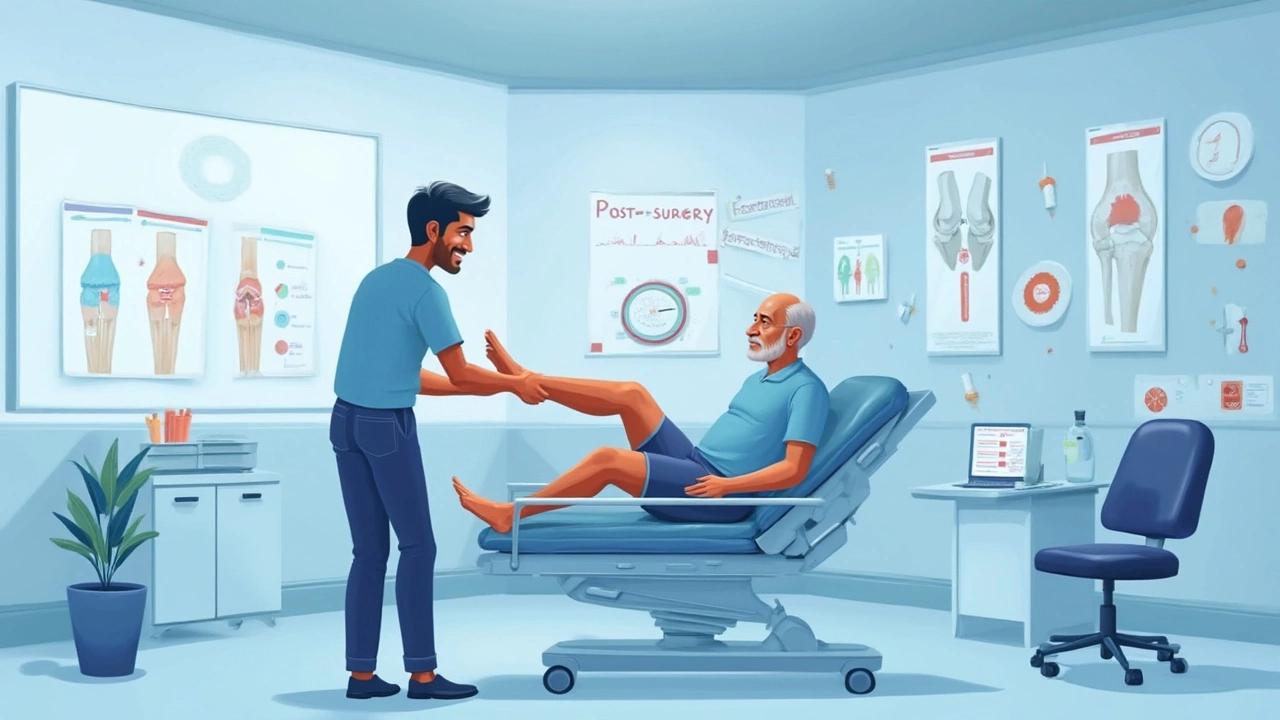Picture this: it’s the first night after your knee replacement surgery, and suddenly, getting comfortable becomes a challenge you never signed up for. There’s all this talk about keeping your leg straight, but nobody really tells you how long you’re in for, or why it matters so much. If you’re already counting sheep and running out of patience, you’re not alone. Let’s crack into what really happens and what you need to know if you’re staring down weeks of sleeping with your leg sticking out like a baseball bat.
The Science Behind Sleeping with Your Leg Straight After Knee Replacement
Right after knee replacement surgery, your new joint and the soft tissues around it need time to heal and settle into place. Keeping your leg straight isn’t just some medical tradition—it’s about avoiding stiffness, keeping your new joint aligned, and making sure scar tissue doesn’t lock up your movement. And it has a real impact on whether you’ll be able to walk normally and pain-free in a few months. Surgeons and physical therapists are pretty united on this: the first couple of weeks are critical. They’ll usually ask you to keep your leg as straight as possible, especially when you sleep.
Why straight? Think of it like giving your new knee the best shot at healing evenly. Bend your knee for hours at a time, and your muscles, tendons, and the actual joint can develop tight spots or, worse, early contractures—that’s when your body develops a lasting bend. According to the American Academy of Orthopaedic Surgeons (AAOS), patients who kept their leg straight as recommended were more likely to regain full extension—that means your leg can flatten all the way when you’re lying on your back—in just 2 to 4 weeks. Full extension is huge for walking easily and reducing limps... nobody wants a permanent shuffle.
But here’s where it gets interesting: a study published in The Journal of Arthroplasty found that most people actually struggle with this. Nearly 60% found it difficult to sleep with their leg in a straight position, especially during the first 10 days post-op. It’s not just physical comfort—it can mess with your sleep, your mood, and your sanity. Pain, swelling, and that all-too-familiar throbbing can wake you up every few hours. Sleeping with a pillow under your knee might seem tempting, but it can actually slow down your progress. Surgeons warn that this can reduce your chances of getting that all-important extension back. Instead, they suggest placing a thin, firm pillow or rolled towel under your ankle so your knee stays straight, not propped up or bent. Awkward? Yes. Necessary? Absolutely, especially if you want your recovery to go as smoothly as possible.
If you’re dealing with swelling, ice packs and elevation (leg above heart level) during the day can help. At night, it’s more about staying straight than worrying about fancy positions. To really get that good extension, your physical therapist might even ask you to prop your heel up and let gravity do the work when you’re watching TV or napping. This position gently encourages your knee to straighten out, even if it feels a bit uncomfortable for the first week or two.
| Recommendation | First 2 Weeks | Weeks 3-6 | After 6 Weeks |
|---|---|---|---|
| Leg Position (While Sleeping) | Keep as straight as possible | Can begin gentle bends if cleared by PT/doctor | Normal comfortable positions, avoid prolonged bending |
| Pillow Under Knee | No | Still avoid for most, check with PT | Rarely okay, get professional advice |
| Extension Exercises | Daily, several times a day | Continue daily | As advised by PT |
So, how long do you need to keep your leg straight? For most people, the drill is two to three weeks of disciplined straight-leg sleeping, with another three to four weeks of ‘as much as you can tolerate’—that means if you can sneak in a gentle bend for brief periods, great, but the baseline should still be straight. By week six, most folks go back to sleeping however they want, but it all depends on your progress and your doc’s instructions.

What Real Recovery Looks Like: The Timeline and Tough Spots
Recovery from knee replacement isn’t a straight line. You’ll get days where bending or keeping it straight feels impossible, and nights when you’d do anything to sleep with your leg curled up. Let’s break it down week by week, so you know what to expect.
Week 1 brings the most drama. Your knee is swollen, stiff, and sore. Expect to shift and reposition a lot at night. Staying straight will feel unnatural, and you may wake up with your leg accidentally bent. That’s okay—just reposition and try again. Your pain meds and icing routine will be key here.
Week 2, you’ll notice any swelling is finally heading the right direction, but stiffness is still hanging around. It’s crucial to build the habit now: spend as much time as possible with your leg straight, especially during naps and nighttime sleep. Some people start gentle stretches under supervision at this point, but the straight-leg sleep is still a non-negotiable.
Between Weeks 3 and 4, you should start regaining control of your knee. Your range of motion is improving, both straightening and bending. Physical therapy sessions get more interesting, mixing in extension and flexion exercises. You might sneak in a side-sleep on the non-surgery leg with a big pillow supporting your surgical side (check with your PT!). This is also when many start sleeping a bit better—your brain, and your body, are getting used to the new normal.
Beyond 4 weeks, the rules relax for most people. If you’ve regained full extension and have decent bending ability (usually at least 90-110 degrees by 6 weeks), you can try different sleep positions. If you’re still struggling to fully straighten your leg after six weeks, your surgeon or therapist may recommend more targeted exercises or even a special splint overnight. The point is, don’t panic if it feels slow; stiffness sometimes lingers up to three months. Talk to your PT and surgeon if something feels off or isn’t improving.
Here’s an honest fact: sleeping after knee replacement is a challenge for almost everyone. Whether it’s joint pain, strange swelling, or just not finding the right position, you might struggle to get quality rest. One interesting stat: The Hospital for Special Surgery in New York surveyed 500 knee replacement patients, and 70% reported sleep problems in the first month. Yet the majority saw big improvements after sticking to their prescribed routines. Good sleep helps healing, so don’t neglect this part of your recovery. If insomnia gets bad, ask your team for tips or medication options—you’re not expected to tough it out solo.
- Stick to a bedtime routine: Wind down the same way each night, even if sleep itself is tricky.
- Elevate and ice before bed: It can make the first couple hours more comfortable.
- Resist the urge to bend: Your sleepy brain wants you to curl up, but your knee needs discipline.
- Stay ahead of pain: Don’t wait til the pain wakes you—take meds as prescribed.
- Keep the room cool and dark: It can help you fall asleep even if you’re uncomfortable.
Sex, driving, going back to work—everyone wants to know when they can get back to normal. Don't rush. Forcing your way back to old habits too soon can undo weeks of hard work. If you can get through those first brutal weeks of sleeping straight, you’re laying great groundwork for the rest of your recovery.

Practical Tips to Make Straight-Leg Sleeping Less Miserable
Alright, let’s get real—keeping your leg straight at night after knee replacement surgery is a pain. Literally. Here’s how I’ve seen people make it a bit more bearable, pulling from physical therapist advice, patient stories, and a few tricks that actually work.
Bedding matters. If your mattress is old and saggy, sleeping flat becomes a fight. Extra-firm mattresses or mattress toppers can help, and some hospitals even use adjustable beds—which lets you keep your upper body propped up while your leg lays flat. Make your own version at home by stacking pillows under your back and shoulders, but keep a dedicated ankle pillow or rolled towel to support your heel. That way, your knee gets a gentle stretch toward full extension while the rest of your body is comfy.
Don’t throw a heavy blanket over your surgical knee—weight on the joint fires up the pain, and can encourage swelling. Instead, drape sheets lightly or tuck blankets around your leg. Light compression stockings (medical grade) can help if you’re cleared to use them. Ask your doctor first, especially if you have problems with swelling or circulation.
Set up your bedroom for easy access to ice packs, pain meds, water, and a bedside commode if you need it. Wobbling to the bathroom at 3 am increases your fall risk, so go for convenience. And watch your walking habits between sleep sessions: keep using your walker or crutches until your PT says it’s safe to ditch them. Limping or hobbling can make your knee recovery slow down, even if you’re only doing it for a few steps at night.
Some people swear by distraction—the right podcast, a calming audiobook, or even guided meditation before bed. Sleep apps with white noise or gentle rain sounds can drown out that weird creak your new knee makes every time you move. The trick is to take your focus off the discomfort.
If sleep still won’t come, try this pre-bed routine each night:
- Ice your knee for 20 minutes, then let it warm up a few minutes before bed.
- Do a gentle heel-prop stretch – put a rolled towel under your heel while you lay flat for 10-15 minutes. Let gravity help straighten your leg.
- Do your prescribed pain or nerve medication about 30 minutes before sleep.
- Settle in with light bedding, keep your leg straight, and distract yourself with something calming.
Recognize that this is temporary. Yes, the straight-leg rule is enforced early for your own good, and yes, it will get easier. As the weeks go by, your brain and body will catch up to your new knee. By about 6 to 8 weeks, your doctor or PT will let you return to looser sleeping positions. The reward? A knee that straightens, bends, and supports you the way you need for the rest of your life.
You might hear stories from friends who tossed their pillows after a week, or others who still struggle with stiffness at three months. Go with what your team recommends, and listen to your own body—some bounce back faster, others need a slower ramp. Just remember: the straight-leg rule isn’t punishment. It’s your ticket to better walking, less pain, and getting all the freedom you want from your new knee.









